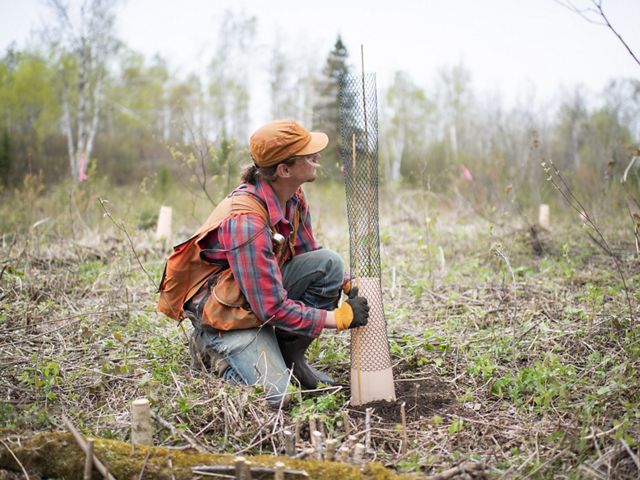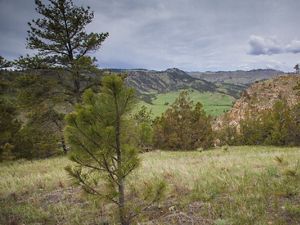Stories in Minnesota, North Dakota and South Dakota
Advancing Climate Solutions
We have a brief window of time for action to make the transition to a more stable climate.
The Nature Conservancy works in Minnesota, North Dakota and South Dakota to advance natural climate solutions while protecting natural lands and waters.
Leveraging Nature to Tackle Climate Change
Natural climate solutions work by ensuring that existing natural areas remain carbon sinks (rather than sources), reducing greenhouse gas emissions or increasing carbon capture. As it turns out, natural climate solutions are the very things we’ve been focused on in our more than 70-year history.

What are natural climate solutions?
Natural climate solutions are conservation, improved land management and restoration actions that increase carbon storage or avoid greenhouse gas emissions in landscapes and wetlands across the globe.
Natural climate solutions are gaining momentum as cost-effective approaches to addressing climate change. And we are continuing our work to influence the smart siting of renewable energy infrastructure and to support other climate solutions that are compatible with the conservation of our great places.
Our biggest opportunities in Minnesota, North Dakota and South Dakota include protection of intact natural areas, grassland and wetland restoration, soil health practices on working lands and reforestation.
The Nature Conservancy (TNC) is committed to our global 2030 goals of reducing or sequestering three gigatons (Gt) of carbon dioxide equivalent (CO2e) per year and abating climate risks for 100 million people through:

- protecting resilient and connected lands that are rich in carbon stocks.
- improving land management to sequester more carbon, retain more water, clean more air and help them adapt to climate change.
- restoring lands and waters to improve sequestration rates.
Our scientists have shown that nature can provide a third of the solution (11Gt CO2e from nature). But we must act now. The potential for these solutions to succeed in slowing the rate of warming is likely to decline after 2030 and dramatically so after 2050.
Nature's Impact
- In Minnesota, natural climate solutions could mitigate 15% of emissions.
- In North Dakota, this number is about 31%.
- In South Dakota, this number is likely around 70% (report coming in 2024).
Thoughtfully scaling our use of nature to tackle climate change is not a substitute for making substantial reductions in fossil fuel use, nor will it alone solve the climate crisis. Even so, natural climate solutions are a critical part of a comprehensive response to climate change and have a multitude of co-benefits including cleaner air and water, increased agricultural yields, preservation of biodiversity and improved quality of life.

Your support makes this work possible.
Thank you for investing in the Climate Solutions Fund!
Climate Solutions in Action
Economic Benefits of Natural Climate Solutions
By conserving, restoring and better managing land, we can increase carbon storage and avoid greenhouse gas emissions through natural climate solutions. And it turns out, we can also save beaucoup bucks.

A new study completed by Earth Economics for TNC in Minnesota shows how investing in natural climate solutions pays out major economic benefits in addition to producing valuable ecosystem services, such as building rich soil, filtering and storing water and providing habitat for fish and wildlife. These benefits support our finance economy and are vital to life.


In fact, natural climate solutions often produce a better return on investment and are cheaper than so-called built, or gray, infrastructure—structures such as dams, seawalls, roads, pipes or water treatment plants. On average, natural climate solutions are half as expensive as built infrastructure, but provide more value due to the additional benefits they produce.
Download
Natural climate solutions are, on average, half as expensive as built infrastructure, but provide more value thanks to their co-benefits.
DOWNLOADThe study found that implementing natural climate solutions produce $8.55 in public benefits for every dollar invested, including improved water and air quality, disaster risk reduction and the recreation economy. They create up to $37 billion in ecosystem services per year and 5,200 jobs. A win-win!
Peatlands Playbook
Minnesota’s peatlands are a highly effective, albeit underappreciated, climate hero. Occupying just 3% of Earth’s surface, peatlands store an estimated 30% of land carbon globally. But despite the incredible things peat does for climate, water quality and even mitigating flooding events, it hasn’t historically gotten the respect it deserves.


However, as interest in natural climate solutions grows, peatlands are increasingly being recognized for the important ecosystem services they provide—including wildlife habitat, perhaps best observed at places like Sax-Zim Bog. And with roughly 6 million acres of peatlands in Minnesota, we have an opportunity to make a big impact for people and nature through restoration and research.
In northern Minnesota’s peatlands, where extensive historic efforts to drain and convert them to forestry and farming occurred, researchers are studying restoration approaches and documenting their findings in a Peatlands Playbook. Once published, their playbook will serve as a guide for future restoration efforts for restoration practitioners working in these fascinating landscapes.
Ecosystem Services Market Consortium
Natural climate solutions aren’t just for organizations or corporations. They’re for everyone, and that includes working farmers.
Take market-based incentive programs, for instance. The Ecosystem Services Market Consortium—or ESMC—is a member-based collective helping farmers improve soil and water health by connecting them to a market that pays for those improvements. Since 2020, TNC has been partnering with ESMC to expand a carbon market across Minnesota. By helping to deploy the program’s corporate sustainability funding on the ground, TNC supports farmers as they expand in-field and edge-of-field practices.

The pilot partnership helps farmers reduce tillage, grow their own livestock feed and plant diverse cover crops to add nutrients to the soil or absorb excess nitrogen—improving soil health, water quality and absorption, and capturing carbon that would otherwise leak into the atmosphere and become harmful CO2e gas. The process is biologically simple, but the impact is deep.
To sell carbon credits, companies encourage farmers to adopt these practices into their operations and then calculate the amount of carbon sequestered to generate a carbon unit, or one metric ton of CO2e. Farmers who enroll in the ESMC get paid for a measurable increase of carbon in their soils. The program is growing to enhance effectiveness and scalability while putting money back into the pockets of the folks who feed our world.
Biological Carbon Capture in North Dakota
North Dakotans can be proud that their state has the potential to capture up to a third of its carbon emissions just through regenerative agricultural solutions.


A 2022 study conducted by TNC found that North Dakota’s natural and working lands are poised to support biological carbon sequestration as a natural climate solution while benefiting the economy and feeding a growing world. The study showed that the Peace Garden State can decrease its CO2e emissions by 31% from their 2018 levels if farmers and ranchers deploy natural solutions to scale, moving us closer to Governor Doug Burgum’s goal of achieving carbon neutrality by 2030.
Download
North Dakota’s farmers, ranchers, and other resource managers can help sequester an estimated 31% of the state’s carbon emissions.
DOWNLOADMany heritage ranchers and farmers have already moved from traditional to sustainable agricultural practices and have found success with strategies like protecting grasslands and wetlands, restoring grasslands and planting cover crops. Cover crops are plants that help improve soil quality, slow erosion, and increase water quality and access. If a farmer plants a cover crop, she or he can keep carbon-eating plants on their land year-round. Benefits to farmers and ranchers have the dual quality of enriching their lands while deterring invasive plant and animal species—including pests and bugs that attack crops.
South Dakota Grassland Protection
As part of our efforts to protect land and water, we are protecting intact grassland through an easement program in South Dakota.
Our conservation technicians work with landowners in central South Dakota to evaluate opportunities to provide easements through agencies like the U.S. Fish and Wildlife Service. They help refer landowners to partner programs for assistance with improved agricultural management. Landowners get the support they need to construct and improve fencing, manage livestock water, propagate native seeds and employ sustainable grazing.


Through easements and other land protection strategies, TNC is also working to increase overall acreage of protection in the Cheyenne River watershed near the Southern Black Hills, which has been deemed a priority area due to its climate-resilience and potential to maintain critical wildlife corridors. A landscape that is “resilient and connected” means that it can provide hardy habitat for a range of species while supporting dynamic shifts in ecosystem composition, and that it creates or has the potential to create land or water bridges to other hardy systems. You can read more about the Resilient and Connected Network in the following 12-year study involving 289 scientists and 14 study regions across the United States: “A resilient and connected network of sites to sustain biodiversity under a changing climate.”
Thank You for Your Support!
Your gift to the Climate Solutions Fund is helping The Nature Conservancy demonstrate the power of nature to mitigate the effects of climate change through carbon storage while helping communities and ecosystems adapt to a warming planet. Thank you for being part of the solution.
To support this work with your next investment in natural climate solutions, renewable energy siting and climate policy, contact Minnesota-North Dakota-South Dakota Director of Philanthropy Jamie Ziemann.





